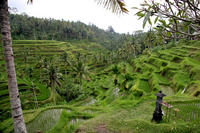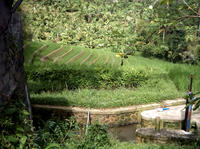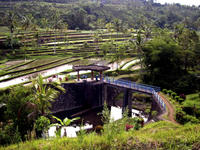You are in: Asia -> Indonesia -> Cultural Landscape o... , and traditional search or Image Gallery will yield results of this site only
Cultural Landscape of Bali Province: the Subak System as a Manifestation of the Tri Hita Karana Philosophy
| Site number: | 1194 |
|
| Type of site: | Cultural | |
| Date: | 9-18 centuries | |
| Date of Inscription: | 2012 | |
| Location: | Asia, Indonesia, Bali | |
Up to 75 images are shown here. Click on each for more details or on Image Gallery for more images.
| Description: | The cultural landscape of Bali consists of five rice terraces and their water temples that cover 19,500 ha. The temples are the focus of a cooperative water management system of canals and weirs, known as subak, that dates back to the 9th century. Included in the landscape is the 18th-century Royal Water Temple of Pura Taman Ayun, the largest and most impressive architectural edifice of its type on the island. The subak reflects the philosophical concept of Tri Hita Karana, which brings together the realms of the spirit, the human world and nature. This philosophy was born of the cultural exchange between Bali and India over the past 2,000 years and has shaped the landscape of Bali. The subak system of democratic and egalitarian farming practices has enabled the Balinese to become the most prolific rice growers in the archipelago despite the challenge of supporting a dense population. --WHMNet's description is from WHC Site, where additional information is available. | |
| Subak is the name of water management (irrigation) system for paddy fields on Bali island, Indonesia. For Balinese, irrigation is not simply providing water for the plant's roots, but water is used to construct a complex, pulsed artificial ecosystem. Paddy fields in Bali were built around water temples and the allocation of water is made by a priest. Subak had been described by Clifford Geertz, but it was J. Stephen Lansing who drew attention to the importance of the traditional system. He was studying Balinese temples, focusing on the water temples, whose importance tended to be overlooked by foreigners. In 1987 Lansing worked with Balinese farmers and agriculture officials to develop computer models of the subak, demonstrating its effectiveness. Officials finally acknowledged its importance. On June 2012, Subak has eventually been enlisted as a UNESCO world heritage site. Cultural Landscape of Bali: the Subak System as a Manifestation of the Tri Hita Karana Philosophy forms a cultural landscape of five rice terraces and their water temples that cover 19,500 hectares. The temples are the focus of a cooperative water management system of canals and weirs, known as subak, that dates back to the 9th century. Included in the landscape is the 18th-century Royal Temple of Pura Taman Ayun, the largest and most impressive architectural edifice of its type on the island. The subak reflects the philosophical concept of Tri Hita Karana, which brings together the realms of the spirit, the human world and nature. This philosophy was born of the cultural exchange between Bali and India over the past 2000 years and has shaped the landscape of Bali. The subak system of democratic and egalitarian farming practices has enabled the Balinese to become the most prolific rice growers in the archipelago despite the challenge of supporting a dense population. --Wikipedia. Text is available under the Creative Commons Attribution-ShareAlike License. | ||
| Source: | http://whc.unesco.org/en/list/1194 | |
| Reference: | 1. UNESCO World Heritage Center (http://whc.unesco.org/en/list/1194). 2. Wikipedia. | |
















